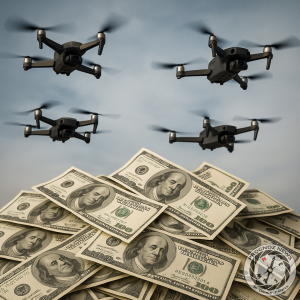Dollars for Drones: Private and Public Funding of the Burgeoning Ukrainian Drone Industry

By Matthew Parish, Associate Editor
The evolution of Ukraine’s drone industry represents one of the most striking transformations in modern wartime economics. Since the beginning of Russia’s full-scale invasion in 2022, drones have moved from an auxiliary role in reconnaissance to a decisive instrument in both offensive and defensive warfare. The pace of this transformation has been driven not only by necessity but also by the rapid mobilisation of capital — both public and private — in support of an unprecedented wartime technological interconnected system. The resulting collaboration between state institutions, diaspora donors, volunteer networks and private investors has created a hybrid funding model that blends patriotic philanthropy with the logic of venture capital, forging an industrial base that now underpins much of Ukraine’s modern combat capability.
The State as Financier and Regulator
The Ukrainian government’s involvement in drone development began with piecemeal initiatives, but by 2023 it had become a central pillar of her war economy. Programmes such as “Army of Drones”, launched under the auspices of the Ministry of Digital Transformation and the General Staff, channelled public funds into the procurement of both domestically produced and foreign-supplied unmanned systems. The government began issuing grants to private manufacturers for research, design and testing, while streamlining bureaucratic procedures for military certification and export licensing. By 2024, at least 200 Ukrainian drone firms were officially registered, many producing variations of first-person-view (FPV) combat drones and long-range strike models capable of reaching deep into Russian territory.
These state mechanisms were often coupled with crowdfunding campaigns, enabling ordinary Ukrainians to donate directly to drone production. The practice blurred the boundary between taxpayer support and voluntary contribution. The state became a curator of private initiative: setting procurement priorities, ensuring technical interoperability, and providing security vetting for sensitive designs. In doing so, the government achieved what Western defence bureaucracies have often failed to accomplish — a dynamic partnership between public oversight and private innovation during wartime.
Volunteerism and Crowdfunded Warfare
Ukraine’s volunteer culture, a legacy of 2014, found new life in the drone revolution. Civilian groups such as Serhiy Prytula’s Foundation, Come Back Alive, and a host of smaller initiatives collected millions of dollars in private donations, transforming crowdfunding into a parallel armaments system. This informal sector often outpaced state procurement, particularly in producing FPV drones, electronic warfare kits, and 3D-printed components. Many of these groups relied upon small workshops scattered across industrial suburbs or even private garages — a testament to the decentralised resilience of Ukraine’s war economy.
The diaspora also played a critical role. Ukrainian communities in North America and Western Europe financed entire production lines, establishing charitable partnerships with firms inside Ukraine. In the United States and Canada, Ukrainian-owned technology companies began supplying components and software to domestic partners under export licences, creating a transatlantic production network that skirted the edge of traditional defence contracting. These efforts were frequently coordinated through patriotic appeals on social media, illustrating how twenty-first-century crowdfunding can rival conventional military procurement channels in both speed and flexibility.
Private Capital and the Emergence of a Wartime Venture Market
Alongside public and philanthropic funds, private investors — both Ukrainian and foreign — began treating drones as a legitimate and potentially lucrative sector. In 2024, several venture funds emerged specialising in military technology, often backed by Western entrepreneurs with ties to Ukraine. These investors provided seed capital, technical mentorship and export market access to promising start-ups developing autonomous navigation, swarm coordination, and AI-driven targeting software.
A new generation of Ukrainian engineers, many with backgrounds in IT and robotics, formed small but agile enterprises capable of rapid prototyping. Some entered partnerships with established defence manufacturers; others sought direct contracts with the Ministry of Defence. The appeal to investors lay in the dual-use nature of the technologies: many wartime innovations — in aerial mapping, machine vision, and secure communications — have potential civilian applications in agriculture, infrastructure, and logistics once peace returns. Hence, the Ukrainian drone industry stands at the intersection of necessity and opportunity, where patriotic duty converges with market rationality.
However challenges persist. Investors must navigate export-control regimes, corruption risks, and the unpredictability of a battlefield-driven market. Insurance, intellectual property protection and international certification all remain imperfectly developed. Yet the very existence of an investment environment in wartime Ukraine demonstrates a remarkable degree of institutional adaptation and resilience.
International Assistance and Strategic Implications
Western governments have also played an indirect but decisive role. The United States, United Kingdom, and European Union have financed drone procurement through military aid packages, while simultaneously fostering conditions for private-sector involvement. American and European companies have begun exploring co-production arrangements with Ukrainian firms, sometimes through intermediaries based in Poland or the Baltic States to comply with export restrictions. The logic is clear: Ukraine’s battlefield serves as the ultimate testing ground for drone warfare, and participation in her industry provides strategic insight into the future of combat technology.
This cooperation extends beyond hardware. Joint research projects in artificial intelligence, electronic warfare resilience and counter-drone technologies are emerging as vital fields of collaboration. Western universities and defence contractors increasingly view Ukraine as a living laboratory for innovation under combat conditions. In turn, Ukrainian developers gain access to advanced materials, sensors, and software integration expertise unavailable domestically.
The Future: From Survival to Sovereignty
As Ukraine’s war continues into 2025, the sustainability of her drone sector depends upon a careful balance between central coordination and entrepreneurial freedom. Public funding ensures continuity and strategic direction; private capital guarantees agility and invention. The next stage of development will likely involve institutionalising this partnership through defence-industry clusters, specialised financing vehicles, and international joint ventures. If successfully managed, Ukraine may emerge not only as a consumer of Western military aid but as a producer and exporter of advanced unmanned systems — a transformation with profound economic and geopolitical consequences.
Ultimately the story of “dollars for drones” is one of national self-determination through innovation. In a war fought as much in laboratories as on battlefields, Ukraine’s capacity to mobilise both her citizens’ generosity and the world’s capital markets has become a form of strategic resistance. The drones that now circle above the Donbas and the Black Sea are not merely instruments of destruction; they are symbols of a nation’s creative defiance and of the new economy of modern warfare that Ukraine, through necessity and ingenuity, has come to define.
5 Views




